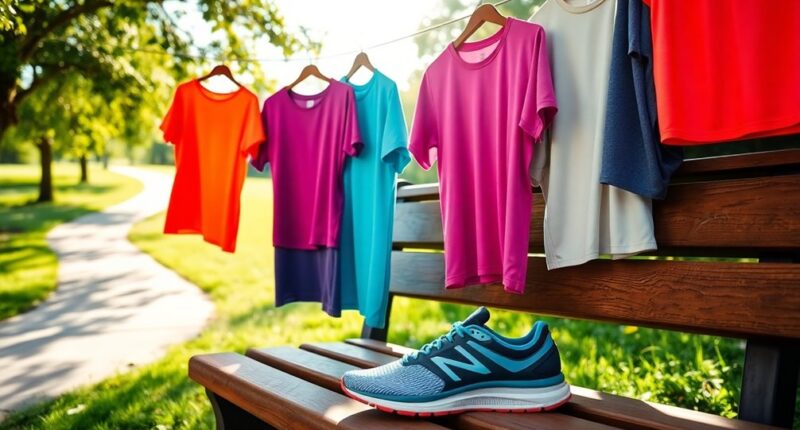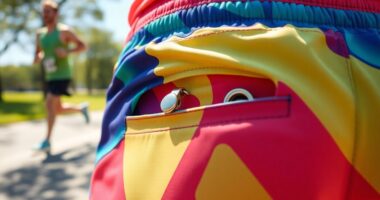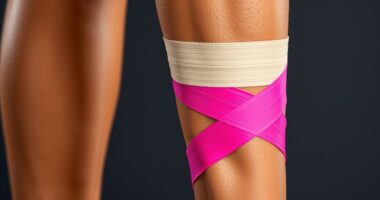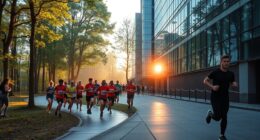When selecting running apparel, focus on moisture-wicking fabrics to keep you dry and comfortable. Choose lightweight, breathable materials for better movement and temperature control. Look for chafe-free designs and reflective elements to enhance safety during low-light runs. Guarantee a proper fit for unrestricted mobility and consider weather conditions to layer appropriately. Don't forget essential accessories, like quality running socks and hydration packs. Keep exploring to find out more about making the best choices for your running wardrobe!
Key Takeaways
- Choose moisture-wicking fabrics like polyester or merino wool to keep skin dry and enhance comfort during runs.
- Ensure a proper fit to allow unrestricted movement and prioritize chafe-free designs for a comfortable experience.
- Select lightweight and breathable materials for warm weather, while layering with moisture-wicking base layers for cold conditions.
- Opt for running socks made from moisture-wicking materials to prevent blisters and maintain foot comfort during workouts.
- Set a budget of $100 to $300 for essential apparel, focusing on quality items and exploring sales for savings.
Key Features to Look for in Running Apparel
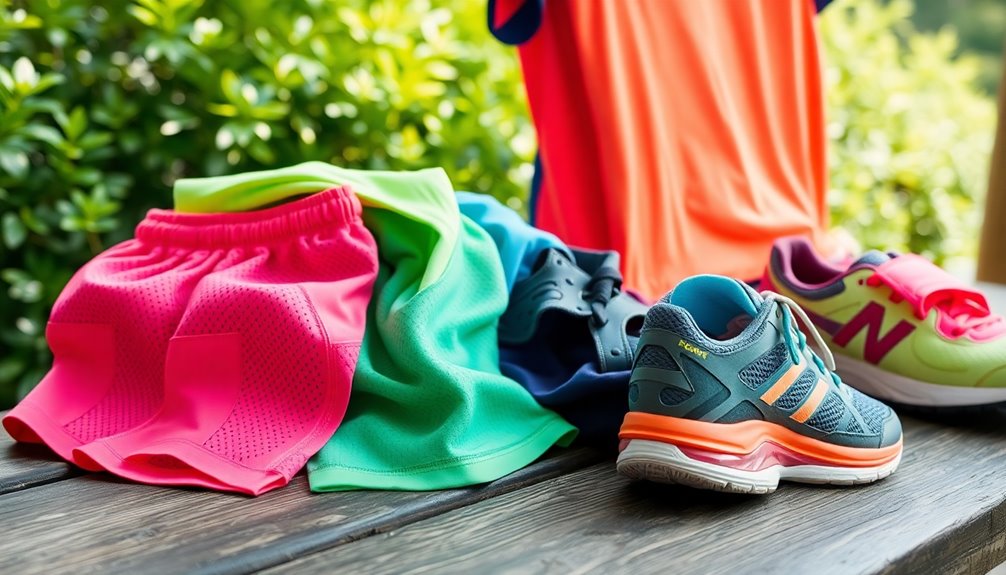
When selecting running apparel, there are a few key features you should prioritize to enhance your performance and comfort.
Look for moisture-wicking fabrics like polyester, nylon, or merino wool to keep your skin dry and regulate body temperature. Opt for comfortable, lightweight, and breathable materials that allow for easy movement, especially on warm days.
It's important to choose chafe-free designs with flatlock seams to minimize discomfort during your runs. Additionally, consider clothing with reflective elements to boost your visibility during early morning or evening workouts, enhancing safety.
Don't overlook features like thumbholes in sleeves, which can provide added comfort and keep your sleeves in place, making your running experience even more enjoyable.
Choosing the Right Fabrics for Comfort

When you're out for a run, the right fabrics can make all the difference in your comfort.
Look for moisture-wicking materials that pull sweat away from your skin and breathable fabrics that allow air to flow.
Choosing these options helps you stay dry and cool, even on the longest runs. Additionally, consider integrating anti-odor running apparel to keep you feeling fresh throughout your workout.
Moisture-Wicking Materials
Choosing the right running apparel can make all the difference in your comfort during a workout, and moisture-wicking materials are crucial for achieving that. Fabrics like polyester, nylon, and merino wool effectively draw sweat away from your skin, keeping you dry and comfortable.
Merino wool also provides excellent temperature regulation and natural odor resistance, making it versatile for various weather conditions. Look for moisture-wicking clothing with high breathability to guarantee air circulation, which helps regulate your body temperature while you run.
Additionally, compression fabrics enhance moisture management by offering a snug fit that supports muscle performance and reduces chafing. By choosing moisture-wicking materials, you can greatly improve your performance and enjoy a more comfortable running experience.
Breathable Fabric Choices
Moisture-wicking materials set the stage for comfortable running, but breathable fabric choices take your experience to the next level.
Opt for breathable fabrics like polyester and nylon, which effectively wick moisture away from your skin, keeping you dry during workouts. Merino wool is another excellent option, offering temperature regulation and moisture-wicking properties, making it suitable for any weather.
Look for quick-drying materials to prevent discomfort from chafing and cold sensations after sweating. Choose lightweight and stretchy fabrics to enhance your freedom of movement, especially on longer runs.
Finally, consider clothing with mesh panels or ventilation zones to boost airflow and help regulate your body temperature, ensuring you enjoy every mile in your comfortable running clothing.
Understanding Fit and Design for Optimal Performance

Finding the right fit in running apparel is vital not just for comfort, but also for enhancing your performance on the track or trail. A proper fit prevents restrictions in movement while avoiding chafing. Opt for moisture-wicking fabrics that keep sweat off your skin, essential for long runs. Flatlock seams are ideal as they minimize irritation.
Here's a quick reference table for your running apparel choices:
| Feature | Importance |
|---|---|
| Proper Fit | Guarantees comfort and mobility |
| Moisture-Wicking | Regulates body temperature |
| Layering System | Provides warmth and flexibility |
| Reflective Designs | Enhances visibility and safety |
Weather Considerations When Selecting Running Gear
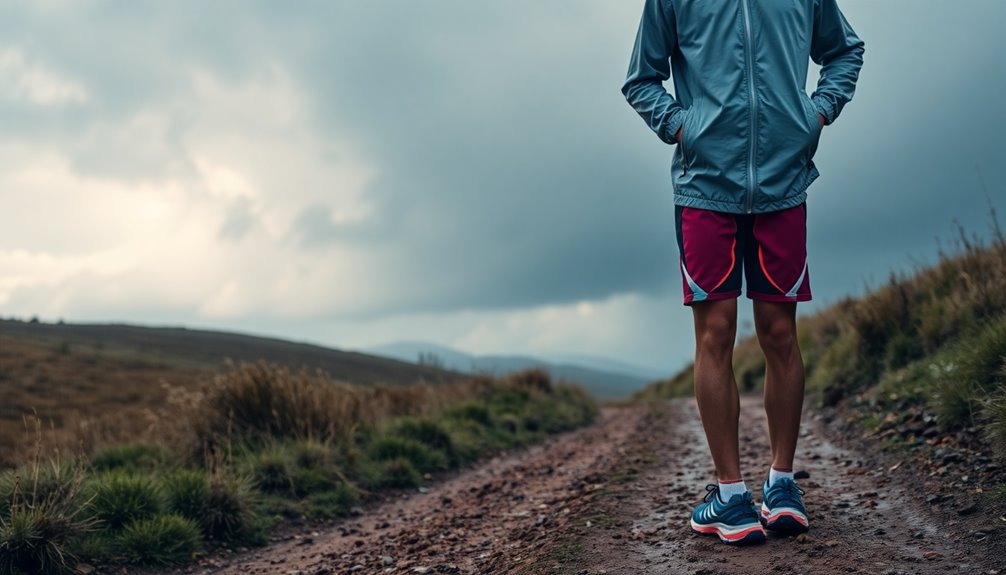
When you choose running gear, the weather plays an essential role in your comfort and performance.
For warm days, lightweight fabrics work best, while colder temperatures call for layers that keep you warm without overheating.
Knowing how to layer and select weather-specific materials will help you stay focused on your run, no matter the conditions.
Temperature and Clothing Choices
Selecting the right running apparel can make a significant difference in your performance and comfort, especially when temperatures fluctuate.
Consider the following options based on weather conditions:
- For warm-weather running, opt for lightweight fabrics like polyester or nylon and choose moisture-wicking shirts to keep cool and dry.
- Prioritize UPF-rated items to protect against harmful UV rays, ensuring higher ratings for better sun defense.
- In cold weather, focus on layering: start with a moisture-wicking base layer, add an insulating mid-layer, and finish with a windproof or waterproof outer layer.
- Don't forget tights or running pants for insulation, along with vests or soft-shell jackets to maintain warmth without bulk.
Always adjust your clothing choices based on personal comfort.
Layering Techniques for Comfort
Layering techniques play an essential role in keeping you comfortable during your runs, especially as weather conditions change.
Start with a moisture-wicking base layer to manage sweat and moisture. For colder days, add an insulating mid-layer made from thermal fabrics, and consider a vest or soft-shell jacket that allows mobility while retaining warmth.
When it's warm, opt for lightweight, breathable fabrics and minimal layers to promote cooling and moisture evaporation. Remember the principle of "dress for the run, not the weather"—wear one layer less than you think you need.
Don't forget about wind and precipitation; a wind-resistant jacket is vital for blustery days, while weather-resistant materials will keep you dry during unexpected rain. Additionally, consider how humidity levels can affect your comfort and adjust your layers accordingly.
Weather-Specific Fabric Recommendations
Choosing the right fabric for your running gear can considerably impact your performance and comfort, especially as weather conditions fluctuate.
Here are some fabric recommendations based on the weather outside:
- Warm Weather: Opt for lightweight, moisture-wicking fabrics like polyester or nylon to keep your skin dry and enhance breathability.
- Cold Conditions: Layer with thermal materials such as merino wool or insulated polyester to retain warmth while managing moisture.
- Windy Days: Use wind-resistant jackets made from nylon or soft-shell materials to combat wind chill without sacrificing breathability.
- Rainy Weather: Choose water-resistant fabrics with a DWR finish to stay dry while allowing sweat to escape.
Also, consider UPF-rated running clothes for added sun protection on hot days.
Essential Accessories for Runners
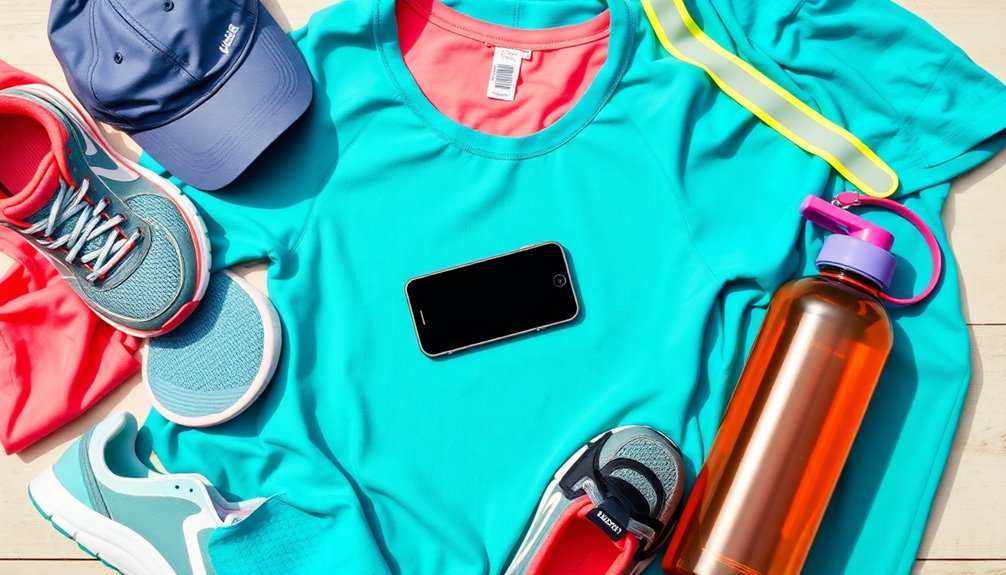
When it comes to running, having the right accessories can make all the difference in your comfort and performance.
Good quality running socks made from moisture-wicking materials will keep your feet dry and prevent blisters, so don't skimp on them—brands like Nike and Salomon are excellent choices.
For headwear, opt for lightweight caps or headbands that regulate temperature and provide sun protection.
If you're running in colder weather, moisture-wicking gloves are vital to keep your hands warm and dry.
Hydration accessories like packs or belts are essential for staying hydrated; just make sure they're lightweight.
Finally, don't forget reflective gear for enhanced visibility during low-light runs, ensuring you stay safe while hitting the trails.
Budgeting for Quality Running Apparel
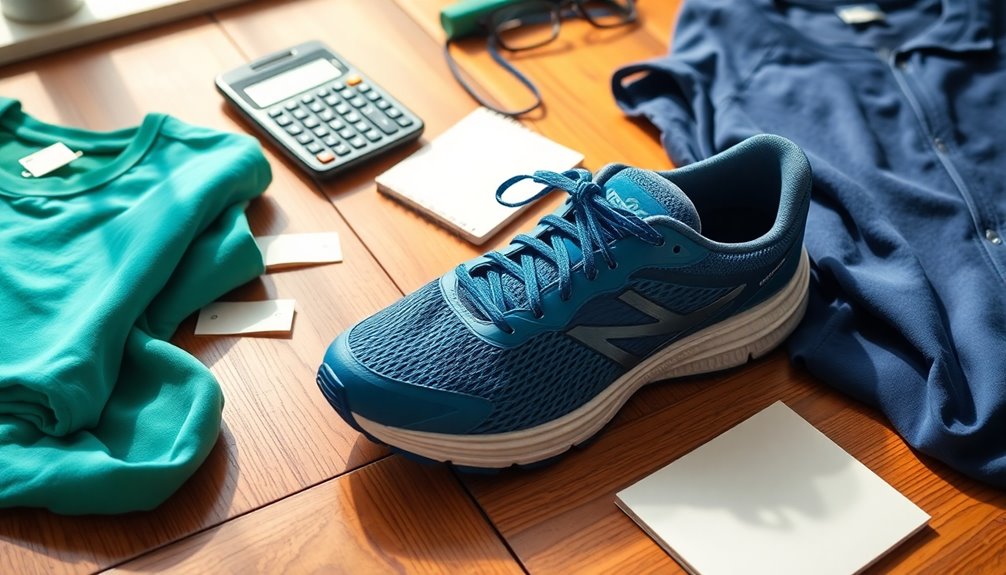
Investing in quality running apparel can greatly enhance your experience, especially if you plan to run regularly.
When budgeting for quality, aim for around $100 to $300 for your essential running apparel. Here are some tips to take into account:
- Start with the basics: A good pair of moisture-wicking shirts and shorts is vital.
- Look for deals: Check for sales at local running stores to save 20% to 50%.
- Prioritize fabric: Choose quick-drying materials to help you stay warm and comfortable.
- Build gradually: Invest in a few key pieces first, then expand your collection as needed.
Frequently Asked Questions
How Often Should I Replace My Running Apparel?
You should replace your running apparel when it starts showing signs of wear, like fading, stretching, or loss of moisture-wicking properties.
Generally, every 6-12 months is a good rule of thumb, depending on how often you run and the conditions you face.
If you notice discomfort or chafing, it's definitely time for new gear.
Keeping your apparel fresh helps you stay comfortable and motivated during your runs!
Can I Wear Cotton for Running?
You might be tempted to wear cotton for running, but it's not the best choice.
Cotton absorbs sweat, which can leave you feeling heavy and chafed during your run. Instead, opt for moisture-wicking fabrics that draw sweat away from your skin, keeping you cool and comfortable.
If you do wear cotton, make sure it's blended with synthetic materials to help manage moisture better.
Your runs will feel more enjoyable and less taxing on your body!
What Sizes Should I Try for a Good Fit?
Finding the perfect size can feel like hunting for a needle in a haystack!
To nail the fit, you should measure your chest, waist, and hips, then compare those numbers to the brand's sizing chart.
Don't be shy about trying different sizes; sometimes, you'll need to go up or down a size depending on the cut.
Are There Running Clothes Specifically Designed for Women?
Yes, there are running clothes specifically designed for women.
These garments take into account the unique fit, support, and comfort needs of female runners. You'll find features like tailored cuts, moisture-wicking fabrics, and built-in support in sports bras.
When shopping, look for brands that focus on women's performance wear to guarantee you get the right fit and functionality.
Trying different styles will help you discover what works best for your body.
How Do I Properly Care for My Running Apparel?
Think of your running apparel as delicate friends who need a little TLC.
To keep them in top shape, wash them in cold water on a gentle cycle and avoid fabric softeners, which can ruin moisture-wicking properties.
Air-drying is best; it preserves elasticity and fit. If you must tumble dry, use low heat.
Finally, store them in a cool, dry place to prevent any unwanted surprises.
Treat them well, and they'll serve you longer!
Conclusion
Choosing the right running apparel can feel like finding the holy grail of comfort and performance. By focusing on key features, fabrics, fit, and weather conditions, you can elevate your running experience to new heights. Don’t forget the essential accessories that can make all the difference! Investing wisely in quality gear not only boosts your confidence but also transforms every run into a thrilling adventure. So lace up, gear up, and hit the pavement—your journey awaits! To enhance your running experience even further, consider seasonal running gear tips that align with the changing weather patterns. In the colder months, layering is essential to maintain warmth without overheating, while breathable fabrics are crucial during the summer to wick away sweat and keep you cool. Remember, the right gear not only protects you from the elements but also motivates you to stay consistent on your journey, no matter the season.
